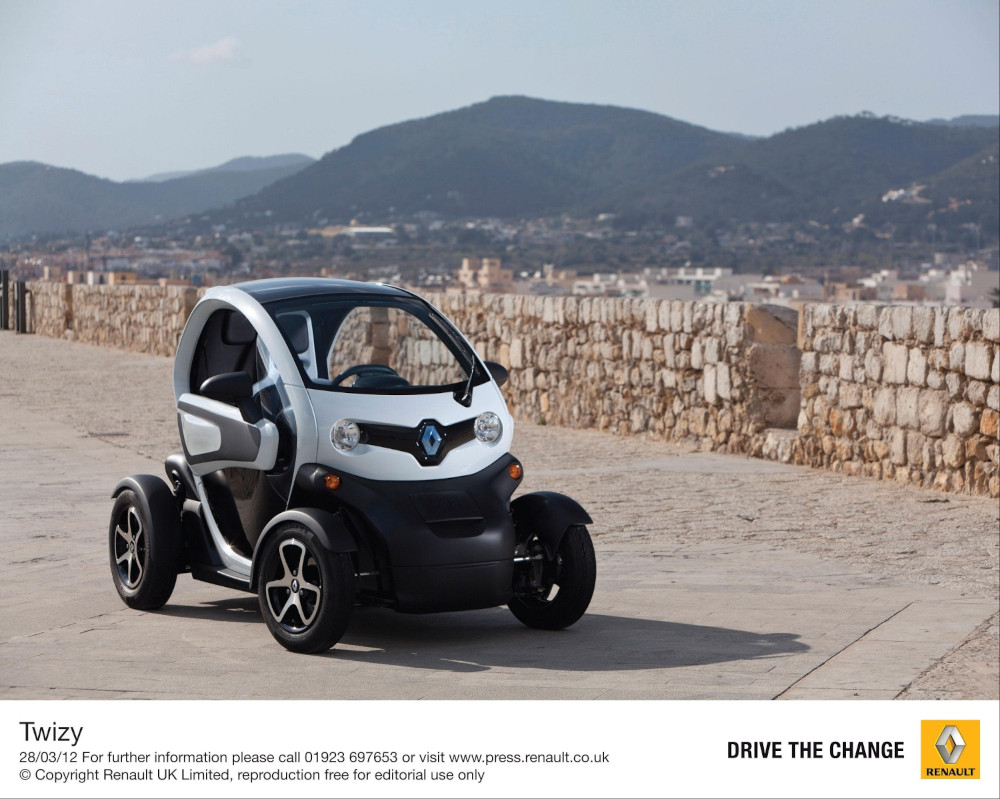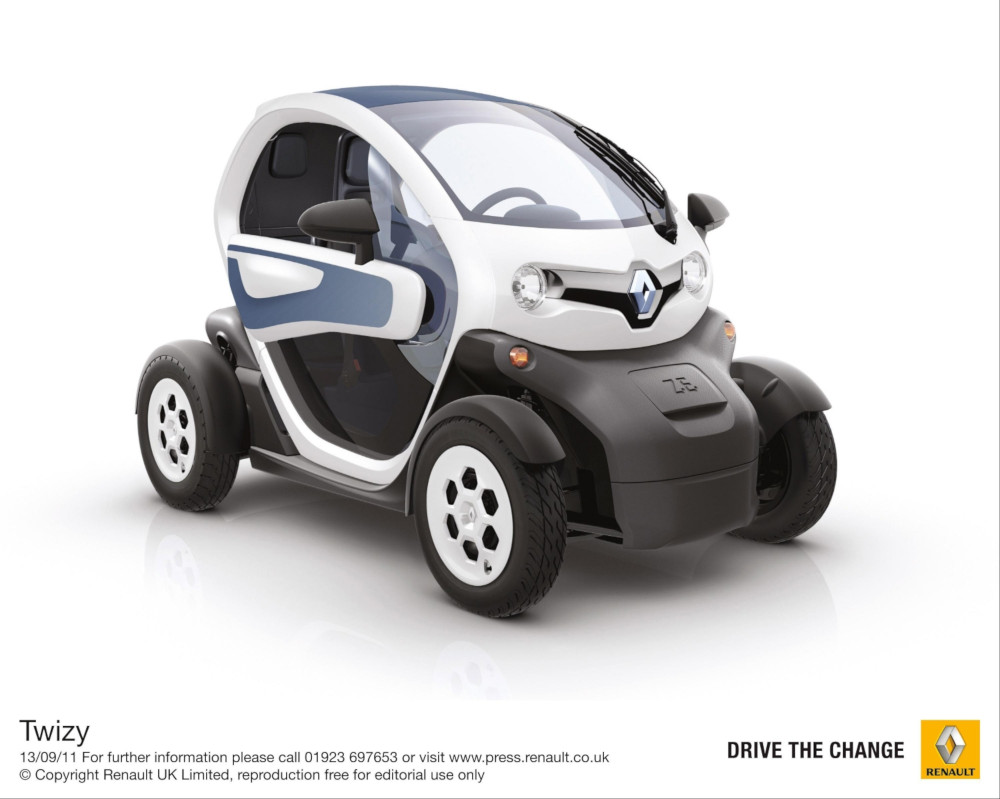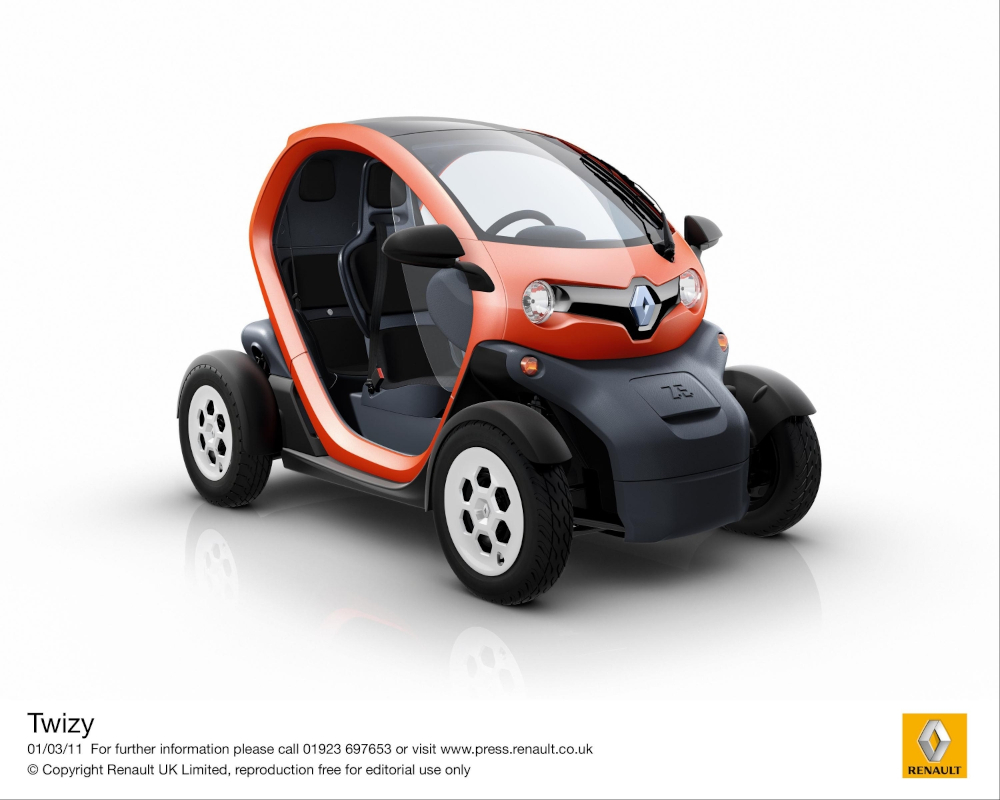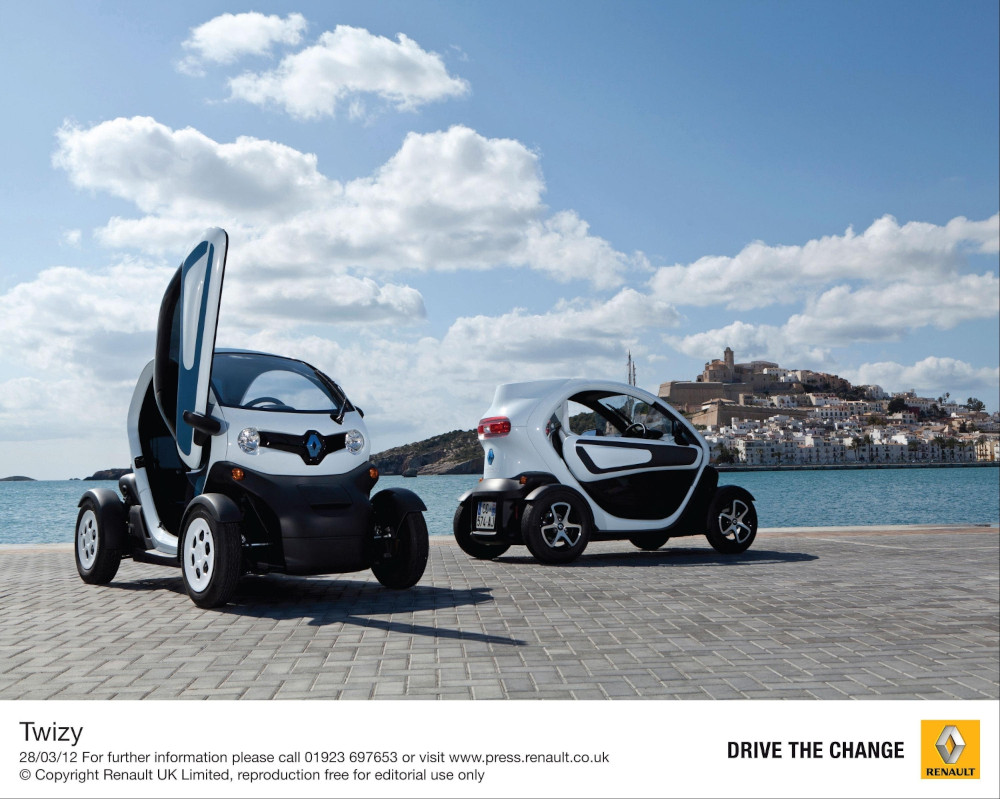In November 2020, I decided to buy some sort of electric car. The COVID-19 pandemic seemed to get into a never-ending story (which held true) and my girlfriend needed a dry way to reach her outdoor sporting activity throughout the winter. Since we are living in the urban area of Berlin, parking area is sparse. We were also searching for something cheap in terms of price and reoccurring cost. During the past 5 years we got along with public transport really well. However, some places are hard to reach and mask-discipline in Berlin transportation is bad.

Finding and buying a Twizy
Based on our criteria (cheap, no long drives, space for two, electric, easy to park) a Renault Twizy seemed like a good option. We found one Twizy at a local car dealership and bought it for 3,800€. At that point, the Twizy had run 19,000km over the past 9 years. It is one of the first models, produced in June 2012. The car dealership was enthusiastic to get rid of the car, as it cost them a monthly battery rent of 50€.
Since the breaks were rusty from the long standing, we negotiated 500€ for an all-wheel replacement of the break pads and discs. The car dealer also handled the German TÜV and registered that car to our name. Unfortunately, the dealer did not understand that electric cars in Germany can have a special number plate, trailed by an “E”. We got a regular number plate instead, which is fine for Berlin. In some other cities, electric cars are allowed to use bus lanes and special parking.
In total we payed 4,300€ for the Twizy. In addition to the contract I had to sign taking over the monthly battery rent. That was fine for me, as I never planned to pay battery rent. Since 2018, Twizy owners can buy their batteries from the Renault Bank. The price depends on the battery age. Since my car is one of the first, the battery only costs around 400€. With the battery rent, Renault guarantees to replace the battery if it is below 75% capacity and help you out in case you run out of juice away from a charging station. All battery parameters can be read out using an OVMS. At the time of buying, my battery was at 92% state of health and 98% capacity - really decent for a 9 year old pack. Therefore, I did not have concerns on buying the battery.
About the Twizy
The Renault Twizy is a four wheel electric micro-car produced by Renault since 2012. From 2012 to 2019, Renault produced the car in Spain, but production moved to South Korea after that. The Twizy has stayed largely unchanged over the past decade. The onboard electric charger was reconfigured in 2013 after a number of thermal-related defects and design options changed over time. Somewhere along the way, Renault introduced a panoramic roof. Unfortunately, the transparent roof is made from plastic and lacks any UV coating, leading to sunburn, depending on your hairstyle.

The Twizy was produced in two variants and seating configurations, that could be mixed and matched. Our car is the two-seater version, which lacks a trunk. The seats are behind each other and the passengers legs go left and right of the drivers seat. Other Twizys (“Cargo”) replace the passenger seat by a rear-accessible trunk. The cargo variants are often used by delivery services. To my knowledge, production of the Twizy Cargo stopped in 2019, as it moved to Korea.

The Twizy can be ordered with and without scissor doors. From my experience, about 90% were sold with doors and I definitely recommend them. They provide a safer feeling and you gain a lot of storage space left and right of the drivers seat that could not be used otherwise.

Performance-wise, Renault sells the Twizy 80 with 8KW and 80kph top speed, and the Twizy 45 with 6KW and 45kph top speed. The peak power of the Twizy 80 is 12.6 KW, equaling 17 horsepower. Our Twizy is the 80kph version. In Germany, you need a drivers license for cars to drive a Twizy 80, while the less-powerful 45 variant can be driven with an easy-to-obtain scooter license.
Renault claims a range of 90km under optimal conditions from the 6.6KWh battery. In the real world, the range is heavily dependent on the speed you are driving. With a constant 30kph, even our old battery will easily achieve the claimed range. Another important factor is the outside temperature. The difference between -10°C and +20°C can easily be 30% of the range.
All Twizys have a driver-side airbag and two (!) driver seatbelts.
The first winter
When we took over the car in early 2021, Berlin was in one of the coldest winters since I am in the city. The temperatures were absolutely freezing and a thick layer of snow covered the city. These are horrific conditions for a 500kg two-wheel drive electric car with tiny summer wheels, a 9-year old small battery, and no windows. The Twizy does not have ABS or any stability controls, apart from the drivers level of attention.
Some aspects of the Twizy were disturbing compared to a regular car: The indicator makes a distinct “beep” noise and, since there are no windows, you can hear your surroundings like you are on a bike. After a year of driving I embrace the additional sense you are lacking in a regular car. In the Twizy, you can hear cars coming before seeing them. In a city I feel like this is an security feature. It can be awkward to wait besides a biker at a traffic light, as you can hear their conversations, and they can hear your indicator noise.
During the winter gloves are a must, and taking a hot-water bottle with you is a pro tip for longer drives. You do not feel a lot of wind on the drivers seat, but on the passenger side things get stormy above 50kph. We are fine with this, since we usually use the car alone. There are optional windows for the Twizy that could improve the situation, but they are around 500€ and, since the Twizy has no heating, fog up easily. There is also some discussion if and which windows are street legal in Germany.
Compared to regular cars, the Twizy has a manual-powered direct steering. Combined with the low weight, tiny dimensions, and instant power delivery it creates the often-named “go-cart feeling”. This proved to be a big benefit on wet winter roads and even snow. It never felt unsafe to drive, and you always feel in control. Modern city-cars understeer - the front looses grip first and the corner radius increases. Different from that, the Twizy has a tendency to oversteer. On a snowy parking lot and with a heavy foot, it can be a real drift machine.
We made it through the winter without major issues. In March, the 12V lead-acid battery died. The Twizy needs this battery to keep electrical systems running during a stand-still, as the traction battery is switched off when the Twizy is. Renault suggests that the 12V battery needs to be replaced every 5 years. Its a non-standard part, only produced by EXIGE. Since I did not want to do the repair myself on a winter roadside, a local Renault dealer switched the battery for 200€.
Small optimizations
Some things on the Twizy can cheaply be changed for the better. To improve sight in rainy conditions, the wiper should be swapped for a larger blade. I equipped a Bosch Aerotwin AR530S. It takes less than 5 minutes and covers much larger portions of the windscreen.
The Twizy used standard H4 light bulbs. The headlights are motorcycle headlights, which results in a rather inefficient geometry. Osram and Phillips offer brighter H4 bulbs that sacrifice longevity for light output. Since the bulbs are only 20€/pair, I heavily recommend them. With Osram Nightbreaker 200, the vision in dark conditions is much better. There are no German-legal LED bulbs for the Twizy, but some people modify aftermarket LED bulbs to fit.
Attracting attention
Something I did not image, is the level of attention from strangers a Twizy gets. Multiple times a week, I get interviewed by complete strangers on the street, asking about price, range and concept of the car. People take pictures of the car, even with us in it. Kids love the Twizy and the scissor doors. The vast majority of people react very positively.
A strange phenomenon I have witnessed is people talking to me like I’d try to sell them a Twizy. After asking me about it, they make up excuses about how they need to transport stuff and take long trips with their cars. I find this behavior rather odd. It would never cross my mind to approach somebody on the street and tell them how their SUV does not fit my lifestyle. The best reason I can come up with is that the Twizy triggers people, as it is a friendly glimpse into a future without full size SUVs blocking our cities.
Buying the battery
As the seller signaled to Renault that I would take over the battery rent, I expected a letter from the bank. My plan was to approach a Renault dealer with this letter and sign a buying-contract. The Renault bank itself cannot sell the batteries, as they are not allowed to. Instead, the battery is sold by a Renault dealer that pays a portion of it back to the bank.
In June of 2021, I still had received no letter. I therefore tried to call the bank. After 45 minutes of holding the line, the lady from the bank told me, that my battery is not registered in their systems. The “team” (as she called it) would call me on details how to proceed. Needless to say, the “team” never called me.
Instead, I went to a Renault dealership. I was their first customer trying to buy a battery. Usually, the dealership needs to read out the battery data (just like with an OVMS) and report these to the bank. The process costs an additional 100€. My dealership was confused of the process and also failed to read the relevant data. They still offered me a buying contract for 470€, which I instantly accepted. The payment should be handled when the bank confirmed the process. I signed the buying contract, payed nothing, and left the dealership.
As I am writing this, it is November 2021 and the dealership never called me. The bank also never called me. I have a signed buying contract for the battery, but I never payed any rent or the battery itself. After occasional calls with the dealer I have accepted my faith and hope to never hear from any of them again.
Charging
We are living in a rental flat and lack a parking place with a socket. Our Twizy carries a spiral 3 meter Schuko cable in its nose. There is an option for a Type-2 socket instead of the cable to make the Twizy compatible with standard charge points. These options were rarely chosen, as most buyers can charge their Twizy at home.
To be able to charge at public charge points, I bought an adapter from Type-2 to Schuko. The adapter uses one of the Type-2 Phases and converts it to a Schuko plug. It also handles the signalling to start the charge. You can use any Schuko device with this adapter.
My revision of the Twizy charger pulls 2.2KW from the socket, equaling 10A at 220V. This is the maximum endured load for private electrical installations. It equals a 0.3C charge on the battery, so it takes about 3.5 hours to fill up a depleted battery. Modern electric cars charge much faster - on DC charge points, up to 3C can easily be achieved. Some people tune their chargers with additional components to achieve faster charging, but since we are not using the Twizy as a travel mobile, the standard trickle charge works well.
Newer charger revisions limited the charge power to 1.8KW for thermal reasons. The charger itself stayed the same. Using an OVMS, the charge speed can be adjusted. I tend to do this on hot days to avoid the charger to overheat. A new onboard charger costs around 1000€.
I am using a Shell Recharge card. This results in a KWh price of 45ct at my local Allego charge station. Other charge cards might be cheaper, but the differences are minimal due to the Twizy’s tiny battery. A full charge costs around 2.70€ and lasts for 60km on average. This boils down to 4.5ct per Kilometer in energy cost. For comparison: A Volkswagen UP needs about 5.5l/100km in an urban use case. Given a current petrol price of 1.69€/l a kilometer costs 9.3ct in energy - more than double of the Twizy.
Cost
The Twizy is a cheap car, but is is not for free. As an electric L7e vehicle, the tax in Germany is voided until 2022. Mandatory insurance for us is 120€ / year. Regarding maintenance cost, it needed a 12V battery (200€), wiper blade (10€), and H4 light bulbs (20€). We are driving around 3500km per year. On a few occasions we charged at private plugs that were not accounted for. In total, the energy cost was 128€ for 355KWh charged. The resulting monthly maintenance and energy cost for our use case are around 50€.
I am currently looking to switch to all-season tires, which are around 200€ for a set. Wheel rims are rather expensive, going at 280€ for a set of steel rims. For all-season tires, I need to run 135/80 at the front, compared to the original 125/80.
Common issues
The Twizy is a simple car and there is little to break. There are a few common issues:
The windshield heating (antifog) switches corrode, so it randomly turns on and off. Fixing this problem requires to disassemble the dashboard. I only have this issue in moist conditions and chose to ignore it for now.
Between the motor and gearbox, Renault did not add an additional bearing. In the long term, this causes the gearbox to get noisy and break. A additional bearing can be added to mitigate the problem and its a project for me after COVID. The gearbox oil should also be changed after a couple of years.
The charger has the mentioned overheating issue. Repairing a broken charger is rarely possible, so it is recommended to turn down the power with an OVMS on hot days. Chargers with a blue cable are at risk, orange cable chargers are the new lower power revision. The charger’s fan can also be changed for higher airflow.
The Twizy breaks are from a Japanese Quad and tent to corrode and grind. There is no real cure for this, except keeping rain away from the breaks and moving the Twizy regularly.
Great things about the Twizy
For a certain use case, the Twizy is a perfect car without much competition. Unlike a motorbike it shields two persons and their groceries from rain. It is cheap to buy and operate. Its small width is great for many city situations. The short length and massive steering angle always allows to find a parking spot, even in crowded city centers. Last but not least, is a lot of fun to drive.
Not so great things
The range could be greater, but some people are working on replacement batteries. The suspension is stiff, so cobblestone roads are unpleasant. Outside of cities, the top speed could be higher. You will get cold on long winter drives.
Power and top speed can be changed using an OVMS for Twizys build before 2016. These changes are not street legal in Germany.
Should I buy one?
If you need a fun and cheap way to get around your area, have a charging option close, do not mind wearing gloves, and can stand the attention: Yes, I think you should.
